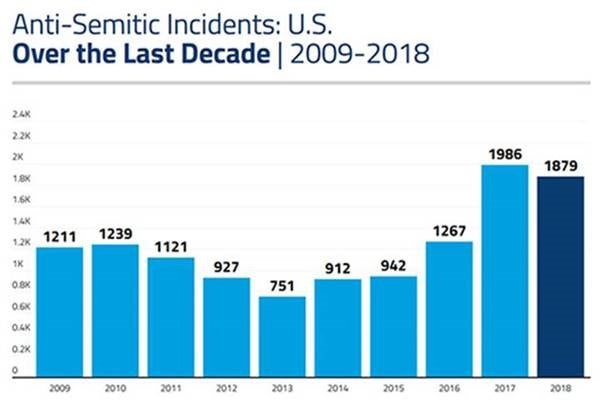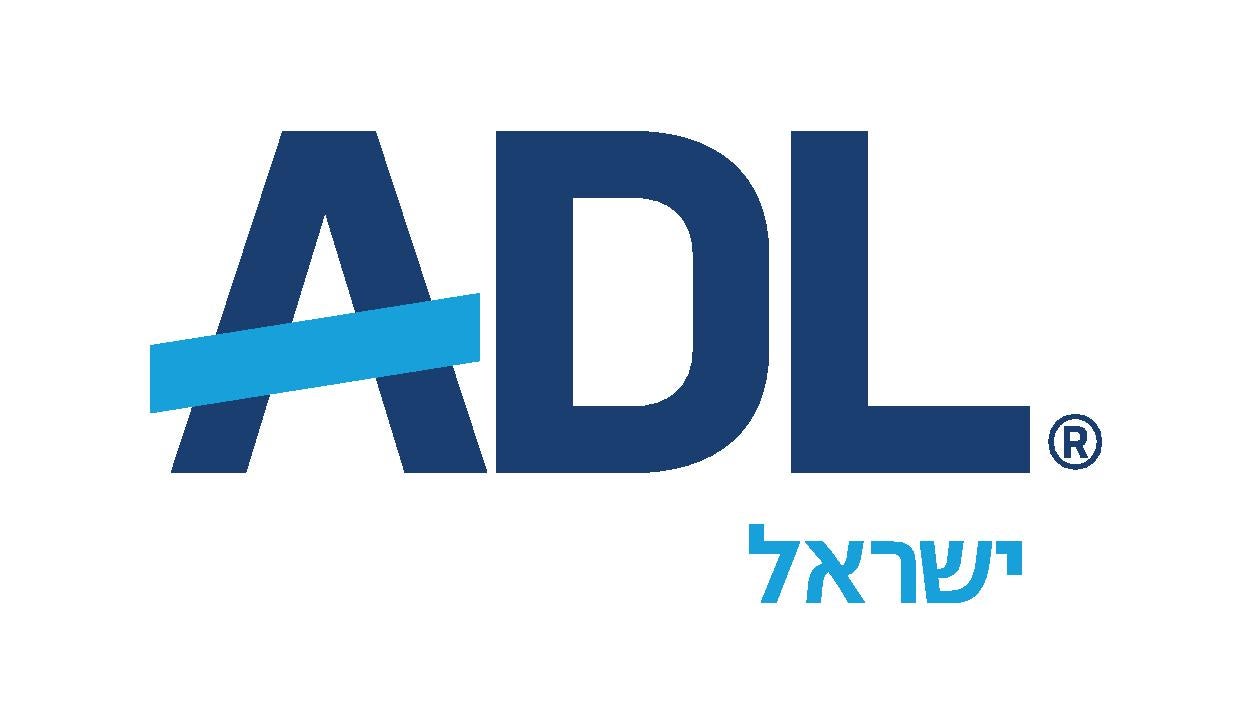
New York, NY, April 30, 2019 …
The U.S. Jewish community experienced near-historic levels of anti-Semitism in 2018, including a doubling of anti-Semitic assaults and the single deadliest attack in U.S. history, according to new data from ADL (the Anti-Defamation League) issued today. ADL’s annual Audit of Anti-Semitic incidents recorded a total of 1,879 attacks against Jews and Jewish institutions across the country in 2018, the third-highest year on record since ADL started tracking such data in the 1970s.
In a year marked by the white supremacist shooting spree at a Pittsburgh synagogue, which claimed 11 lives, and punctuated by a dramatic surge in white supremacist propaganda activity nationwide, ADL’s Audit identified 59 people who were victims of anti-Semitic assaults in 2018, up from 21 in 2017. While the overall number of incidents represents a 5 percent decline from 1,986 incidents reported in 2017, the number of incidents last year remained at near-historic levels – 48 percent higher than the total for 2016 and 99 percent higher than in 2015.
“We’ve worked hard to push back against anti-Semitism, and succeeded in improving hate crime laws, and yet we continue to experience an alarmingly high number of anti-Semitic acts,” said Jonathan Greenblatt, ADL CEO and National Director. “Any decline in anti-Semitic incidents is welcome, and we are heartened by what, we hope, is the beginning of a downward trend in the U.S. But we must remain vigilant in working to counter the threat of violent anti-Semitism and denounce it in all forms, wherever the source.”
ADL’s annual tally of incidents nationwide found that anti-Semitic assaults, harassment and vandalism are still pervasive and at near-historic levels. In addition to the October mass shooting at the Tree of Life synagogue in Pittsburgh, 2018 saw high levels of white supremacist activity, including propaganda on college campuses and in communities, and hateful robocalls aimed at Jewish voters.
ADL’s Audit classifies all incidents into three categories: Assault, Harassment and Vandalism. Of the total incidents reported in 2018:
- Assaults: 39 incidents, marking an increase of 105 percent from the 19 incidents reported in 2017. Those incidents affected 59 victims, up from 21 in 2017, and including the 11 fatalities and two injured congregants in Pittsburgh.
- Harassment: 1,066 incidents of anti-Semitic harassment were reported to ADL last year, a 5 percent increase from 1,015 in 2017 and a 48 percent increase from 721 in 2016.
- Vandalism: 774 incidents of anti-Semitic vandalism were recorded in 2018, down 19 percent from 952 in 2017, but up 52 percent from 510 in 2016.
While most anti-Semitic incidents are not directly perpetrated by extremists, there are interesting connections between the trends. In 2018, 249 acts of anti-Semitism (13 percent of the total incidents) were attributable to known extremist groups or individuals inspired by extremist ideology, making it the highest level of anti-Semitic incidents with known connections to extremists or extremist groups since 2004. Of those, 139 incidents were part of fliering campaigns by white supremacist groups. Another 103 were anti-Semitic robocalls allegedly perpetrated by Patrick Little, an unabashed white supremacist who ran an unsuccessful campaign for U.S. Senate in California.
The Audit also noted spikes at several points during the year. The final three months of the year were unusually active, with 255 incidents in October, 300 in November and 194 in December. The high number in October included 45 propaganda distributions by white supremacists. The incidents in November and December immediately followed the Pittsburgh massacre, which likely drew more attention to anti-Semitic activities. Incidents first spiked in May, when 209 anti-Semitic acts were reported, including 80 anti-Semitic robocalls sent by white supremacists, which targeted Jewish individuals and institutions with harassing messages.
Incidents took place in nearly every state across the country but, consistent with prior reports, the states with the highest number of incidents tend to be those with the largest Jewish populations. These include California (341); New York (340); New Jersey (200) and Massachusetts (144). Combined, these states accounted for more than half of the total incidents in the U.S.
Anti-Semitic incidents took place in a wide variety of locations, including places of business, private homes, public areas such as parks and streets, Jewish institutions and schools:
- At private businesses and retail establishments: 211 (5% increase from 201 in 2017)
- In cemeteries: 8 (up from 7 in 2017)
- In homes: 276 (16% increase from 238 in 2017)
- Incidents on college campuses: 201 (1% decrease from 204 in 2017)
- Incidents in K-12 schools: 344 (25% decrease from 457 in 2017)
- Incidents at Jewish institutions: 265 (23% decrease from 342 in 2017)
ADL’s Center on Extremism has gathered the complete 2018 data, as well as data from previous years on ADL’s H.E.A.T. Map, an interactive online tool that allows users to geographically chart anti-Semitic incidents and events nationally and regionally.
The Audit offers a snapshot of one of the ways American Jews encounter anti-Semitism, but a full understanding of anti-Semitism in the U.S. requires other forms of analysis as well, including but not limited to, public opinion polling, assessments of online anti-Semitism, and examinations of extremist activity, all of which ADL offers in other reports, such as ADL Global 100, Quantifying Hate: A Year of Anti-Semitism on Twitter, Online Hate and Harassment: The American Experience, Murder and Extremism in the United States in 2018, and White Supremacists Step Up Off-Campus Propaganda Efforts in 2018.
HOW ADL IS RESPONDING
ADL has a comprehensive approach to addressing anti-Semitic incidents and behavior, including educating youth to prevent these incidents and working with law enforcement to apprehend the perpetrators. ADL partners with law enforcement to raise awareness of extremist threats and trains law enforcement professionals to recognize and disrupt potential threats. ADL likewise provides education and training every day to students, reaching young people at a time when they are most vulnerable to bullying and social pressures. ADL’s No Place for Hate and Words to Action programs teach understanding and promote inclusivity in schools and on campuses, respectively.
ADL has been a longstanding partner in the effort to ensure the safety of Jewish community organizations and recently announced that former Homeland Security secretaries Michael Chertoff and Jeh Johnson will co-chair a new Community Safety and Security Task Force convened by ADL and the Secure Community Network (SCN), the homeland security and safety initiative of The Jewish Federations of North America and the Conference of President of Major American Jewish Organizations. The task force will work to enhance the safety, security and resiliency of religious communities.
POLICY RECOMMENDATIONS
In response to the historic rise in anti-Semitic incidents over the past three years, ADL has made the following policy recommendations:
- In the aftermath of the deadliest anti-Semitic incident in American history, public officials and civic leaders should use their bully pulpits to speak out against anti-Semitism and all forms of hate and extremism.
- Congress should hold additional hearings on the increase in hate crimes, the rise of extremist groups and proliferation of their propaganda, and support legislation, including the Anti-Semitism Awareness Act, that calls on the federal government to improve coordinated responses and collect data on domestic terrorism.
- Policymakers must support efforts to provide law enforcement officials with the tools and training they need to prevent and effectively respond to hate crimes. Federal, state and local law enforcement agencies should also improve their procedures for responding to and reporting hate crimes.
- School districts should promote anti-bias and bullying prevention programs in elementary and secondary schools. Congress, the U.S. Department of Education, state legislators and mayors should increase funding to promote an inclusive school climate and for anti-bias education and hate crime prevention.
“It is incumbent upon our leaders to continue fighting anti-Semitism at every opportunity,” said George Selim, ADL Senior Vice President of Programs and a former DHS official. “We will continue to advocate for legislative and other remedies to ensure that there is no place for anti-Semitism in our society.”
The ADL Audit includes both criminal and non-criminal acts of harassment and intimidation, including distribution of hate propaganda, threats and slurs. Compiled using information provided by victims, law enforcement and community leaders, and evaluated by ADL’s professional staff, the Audit provides a regular snapshot of one specific aspect of a nationwide problem while identifying possible trends or changes in the types of activity reported. This information assists ADL in developing and enhancing its programs to counter and prevent the spread of anti-Semitism and other forms of bigotry.
The Audit of Anti-Semitic Incidents is a project of ADL’s Center on Extremism, whose work is supported in part by the following generous donors: Roman Abramovich, the David Berg Foundation, The Molly Blank Fund of the Arthur M. Blank Family Foundation, Nathan Cummings Foundation, Ford Foundation, Joyce and Irving Goldman Family Foundation, The Marlene Nathan Meyerson Family Foundation, Rowland & Sylvia Schaefer Family Foundation, Inc., Charles and Mildred Schnurmacher Foundation, The Nancy K. Silverman Foundation, Louis Sobelman, and the Zegar Family Foundation, as well as numerous others.


